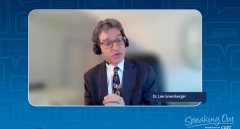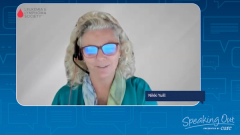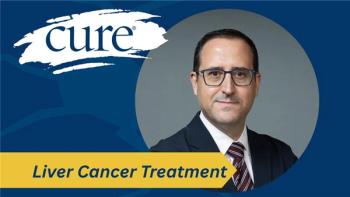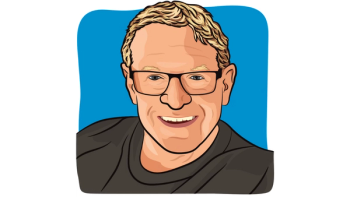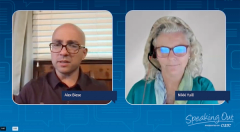
What developments in bispecific antibodies mean for patients with leukemia and lymphoma
As part of its Speaking Out video series, CURE spoke with Dr. Lee Greenberger, chief scientific officer of the Leukemia & Lymphoma Society, who discussed recent treatment advancements and FDA approvals.
Episodes in this series

Transcription:
Alex Biese: Hi, my name is Alex Biese, and I'm the assistant managing editor of CURE magazine. In this edition of the Speaking Out video series, on behalf of the Leukemia & Lymphoma Society, we're speaking with chief scientific officer, Dr. Lee Greenberger, about the FDA pipeline for treatments. Doctor, thank you so much for joining us today. I really appreciate your time.
Dr. LeeGreenberger: My pleasure.
Biese:So, to start off, what are some noteworthy recent FDA approvals? And can you let us know a bit about the science behind these treatments and what sets them apart from treatments that have been previously available to patients?
Greenberger: So this year, this calendar year so far, we've had eight approvals for blood cancer by the FDA, six of them are a first time approval. So we're pretty excited, because that means that these drugs have been approved before. And so, what we're seeing is clearly immunotherapeutics are moving to the very top of the list, we're seeing a whole variety of new immunotherapies to treat primarily lymphomas. In particular, there are new bispecific antibodies. And what that means is a bispecific antibody, what that does is it's a molecule that can bind to the T-cells and bring the T-cells to the tumor cells. So it's got two binding sites, and when you bring T-cells to the tumors, it's capable in the name of the T-cells, to kill the tumors. And so we've seen approval (in December 2022) for mosunetuzumab (Lunsumio) for follicular lymphoma, and there's two other bispecific antibodies that are approved for large B-cell lymphomas, that means diffuse large B-cell lymphoma, and advanced cases of follicular lymphoma. So bispecifics, and in general immunotherapy, we could talk a little bit about CAR-T, and we'll talk a little bit more about that, but generally, engaging T-cells to kill tumors has been really a big advancement in the field, really now approved since 2017 but now we're seeing a wave of bispecifics come through.
Just for the benefit of the audience, CAR-T is this genetic therapy where you could basically take T-cells out of the patient, genetically engineer them and have the T-cells hone on the tumor cells. That requires that cells come out of the patient, go to the lab and (then) back to the patient. And they're quite effective in in the treatment of lymphoma and some leukemias. The bispecifics are off the shelf, what that means is that basically physicians can use these, (patients can) just simply go to the pharmacy and use the drug. And so potentially it's an advantage compared to CAR-T, which is a lengthy process and requires going out of the patient and back to the patient, it requires is actually about three to four weeks to manufacture the cells if you can manufacture them. So that's the first piece.
I should say that back 20, 30 years ago, in the field of cancer therapies, people thought, 'Immunotherapies are really not going to work out well. Maybe the monoclonal antibodies will work, but you can forget the concept of activating the immune system, it clearly didn't work.' And now with the benefit of new technologies, better understanding and combination therapies we're seeing the immunotherapies really advance. It's telling us that the immune system plays a very important role in controlling tumors and in some cases, allowing the tumors to even emerge in the first place when the immune system has deactivated. That's the first piece.
The second thing is we're seeing a wave of new therapies for chronic lymphocytic leukemia. And we've basically transferred over the use of cytotoxic agents which have toxicities all by themselves to basically all medications to treat chronic lymphocytic leukemia. And while these drugs are not curative, there clearly are extending time for patients have (from) when they're treated to getting a relapse. And now we've been able to do that with multiple oral therapies. So, a patient with CLL can go to the pharmacy, take these oral medications and stay on these are on medications for a long duration. So the first generation's oral therapies were approved over 5, 10 years ago. Now we're seeing second generation drugs come through that are more effective, have less side effects and, in fact, can be used in series after one oral therapy — this is called a BTK inhibitor for those of your audience who might be familiar with them — now we're seeing better BTK inhibitors come through and BTK inhibitors that have different mechanisms of actions such that you can use one BTK inhibitor, and you might fail that drug after three or four years on therapy, switch over to a new BTK inhibitor and that drug will continue to have efficacy. So we're not doing curative (treatments) for CLL, we're currently extending the time patients can live with their disease.
So I think those are the two real major advances we're seeing in the FDA approvals and again, six out of the eight approvals, and we're now only about halfway through the year for FDA approvals, are new therapies, and we're averaging about 15 to 20. FDA approvals every year. We've been doing this for about the last five years now. So lots of new therapies, lots of new options for patients as we push the time that patients could go on therapy and stay on it, and hopefully push out overall survival.
Biese: And something you mentioned that seemed really exciting and compelling to me from a patient's perspective, is the concept of the off the shelf immunotherapy. I think anything that increases accessibility and the speed at which patients can get treatment is very, very promising. Tell me a bit about that development specifically about, things becoming more readily available off the shelf in that space of treatment.
Greenberger: Right. So as I mentioned, with CAR-T, it's a three to four week process. It's expensive, it's a one time therapy. The bispecifics are simply just off the shelf, go to the pharmacy, once a drug is approved, of course, and patients can get it immediately. There is a catch with bispecifics: they have to be given multiple times. And so, while it's readily available, and can be manufactured in bulk, anticipating that a patient will need it, they have to be given multiple times. Whereas opposed to the CAR-T therapies, which is one treatment, and then long-term disease control, perhaps cures. I don't think we're there with cures though CAR-T yet. With some of the diseases, we simply just haven't waited long enough. But I know for CAR-T therapy for a certain B-type of acute lymphoblastic leukemia patients are out 10 years, that's a cure, You know, we've got cures.
So, can bispecifics do that? How many times are you going to have to treat with a bispecific? It's still unknown. Many of these drugs are just getting approved within the last year or two. And so we're gonna have to wait a little bit longer to see how bipecifics fair. Now they're all said, when you talk about access to these therapies, therapies are expensive. And so, if they're FDA approved, insurance companies will cover them. Can every patient get access to these expensive therapies and pay the co-pays that might be demanded with these patients or (will it be) the government stepping in and continue to pay for these therapies? That's still a question that it has to get resolved.
Biese: And as you said, there is currently a wave of advancements and approvals happening. What are some anticipated approvals that patients should be aware of and keep an eye out for throughout the rest of ' 23 and into early ' 24.
Greenberger: So, we're seeing a wave of D therapies for multiple myeloma coming through. There is an interesting article that just appeared about a day or two ago talking about (how) it's an embarrassment of riches. We've got lots of options for myeloma patients, and new options are going to appear. So new CAR-T therapies are on the market, there are bispecific antibodies for BCMA that target myeloma, so-called BCMA-directed therapies that are going to get approved and there are new CAR-T therapies that are lined up to get approved or at least evaluated by the FDA within the next six months.
What do I mean by that? Well, we now know that BCMA is this target sitting on the surface of myeloma cells. If you can get the immune cells to recognize it, whether it be bispecific antibody that will bring T-cells, or a CAR-T therapy that can be genetically engineered and bring those T-cells to the BCMA label, if you will, on the on the myeloma cells, they're highly effective. They're not curative, but they're highly effective and can clearly extended time that the disease is under control.
As we get more of these therapies and more combination therapies — and combination therapies from multiple myeloma is very common — how to use these better to push out overall survival for multiple myeloma is the goal. And speaking on behalf of cures, the goal is cures. And, you know, I think that we're seeing CAR-T can be curative, (but) we still have a ways to go of demonstrate cures, and basically have patients get treated and go off drug and now disease doesn't return. That's the definition of a cure. We're not quite there yet. But I think we're seeing very promising results. In the case of myeloma, we're aiming in that direction. We're also going to see better treatments for follicular lymphoma. There is a CAR-T therapy that just got approved for two lymphoma, and now combination therapies with some of the so-called BTK inhibitors that I mentioned, some of the second generation BTK inhibitors plus existing therapies for follicular lymphoma. So we'll see improvements in follicular lymphoma, and we'll see some better supportive care for patients with myelodysplastic syndrome, a very common disease, particularly in older adults, where these therapies look like they may be able to get patients off of chronic transfusions, because they're anemic they require transfusions, some of these new therapies can get patients to be transfusion independent, so they're not coming in all the time to have their red blood cells numbers posted.
Biese: And so we've talked about it from a scientific and from a regulatory standpoint, in terms of FDA approvals. from a patient's perspective, how has the reality of life for a patient with leukemia or lymphoma changed as a result of these recent approvals? And how could these potential upcoming approvals further change the patient's landscape?
Greenberger: Of course, it depends on the disease, and there are about 150 different types of blood cancers. Some that are really difficult to treat. Acute myeloid leukemia, AML, very difficult to treat. And still, we have many new therapies, there are about eight or nine new ones, they're not curing and they do control the disease for a period of time but still AML turns out to be a very tough nut to crack, particularly if you're an older adult. But I think for many of these diseases, (such as) chronic lymphocytic leukemia, Waldenstrom macroglobulinemia, follicular lymphoma, indolent lymphomas, even aggressive lymphomas, diffuse large B-cell lymphoma, basically the time (for) which patients can stay on these drugs and get disease control is clearly improving.
And so, I think patients can anticipate, and you might have heard doctors say, 'Well, you're going to have the disease, but you're not going to die from it, you're gonna die from something else, because we can extend your life for 10 years.' And particularly, many blood cancers are a disease of older adults, so a 70-year-old, say, we can extend your life 10, 20 years with these new therapies, (so) you're not going to die of a blood cancer, you're gonna die of something else, whether it be cardiovascular or otherwise. So I think that's the hope right now, that it could keep their diseases under control, long-term. The goal in the next five to 15 years is, 'How do we convert this to disease control, to cures?' And of course, to know that that's going to happen, it's going to take some time. Patient goes on therapy, let's say it's CAR-T therapy, they get it once. And then you wait five or 10 years and see if it works, and we already have data to demonstrate that it can work. But these newer therapies, we still don't know.
Beyond that, most of the blood cancer therapies are combination therapies, we know this from 50 years of treating acute lymphoblastic leukemia, ALL, (that) combination therapies can be curative for ALL. What is the right combination, and the right patient who has the right cluster of mutations who is going to respond well to these and get rid of the cancer? And beyond that, how can we activate the immune system without it timing out and getting exhausted, to be on patrol, if you will, to kill the tumors and to completely eliminate them, so no rogue tumor cells come back five or 10 years later? But I think we're on that road, and I think, you know, that's what we're gonna see in the next five to 15 years.
Biese: That's very exciting. That's really exciting. All right, Dr. Greenberger, thank you so much for your time today, I so appreciate your insight on this topic. You have a great day, sir.
Greenberger:Thank you.
Transcription edited for clarity and conciseness.
For more news on cancer updates, research and education, don’t forget to


